
The First Australian Imperial Force was the main expeditionary force of the Australian Army during World War I. It was formed as the Australian Imperial Force on 15 August 1914, following Britain's declaration of war on Germany, initially with a strength of one infantry division and one light horse brigade. The infantry division subsequently fought at Gallipoli between April and December 1915, being reinforced by a second division which was later raised, as well as three light horse brigades. After being evacuated to Egypt the AIF was expanded to five infantry divisions, which were committed to the fighting in France and Belgium along the Western Front in March 1916. A sixth infantry division was partially raised in 1917 in the United Kingdom, but was broken up and used as reinforcements following heavy casualties on the Western Front. Meanwhile, two mounted divisions remained in the Middle East to fight against Turkish forces in the Sinai and Palestine.
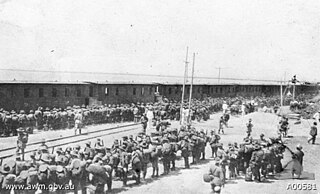
The 17th Battalion was an infantry battalion of the Australian Army. Although its numerical designation was bestowed upon it during World War I, the 17th Battalion can trace its lineage back to 1860, when a unit of the New South Wales Volunteer Rifles was raised in St Leonards, New South Wales. This unit has since been disbanded and reformed a number times. Through its links with the units of the colonial New South Wales defence force, the battalion's history includes service in the Sudan and South Africa. During World War I, the 17th Battalion was raised for overseas service as part of the Australian Imperial Force. Attached to the 5th Brigade, 2nd Division, the battalion was raised in 1915 and sent to Egypt initially, before taking part in the fighting at Gallipoli against the Turks. Later the battalion was sent to the Western Front in France and Belgium, where it served in the trenches as part of the Australian Corps. Throughout the course of the war, the battalion won numerous battle honours and its members received many individual awards, however, at the end of the war the battalion was disbanded in April 1919.
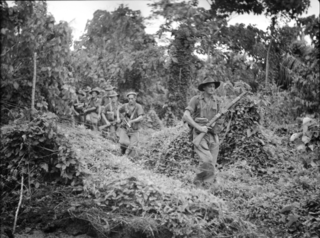
The 19th Battalion was an infantry battalion of the Australian Army. Although the unit's numerical designation was bestowed upon it during World War I, the unit can trace its origins back to 1860 when a Volunteer Rifle corps was raised in South Sydney. During World War I, the 19th Battalion was raised as a unit of the Australian Imperial Force, attached to the 5th Brigade, of the 2nd Division. The unit was formed in 1915 and was first sent to Gallipoli where it fought against the Turks, before being withdrawn from the peninsula and being sent to France in early 1916, where it served in the trenches along the Western Front. Over the next two years the battalion fought in many major battles and won numerous battle honours. In April 1918, it took part in defending against the German Spring Offensive, before the Allies launched their own last-ditch effort as part of the Hundred Days Offensive. The battalion was disbanded in October 1918 due to manpower shortages in the AIF and most of its men were sent to reinforce the other three battalions of the 5th Brigade.

The 16th Battalion, Royal Western Australia Regiment is an Australian Army reserve infantry battalion located in Western Australia and one of the two battalions of the Royal Western Australia Regiment. The battalion was first formed during the First World War, during which it fought during the Gallipoli Campaign and on the Western Front in France and Belgium as part of the Australian Imperial Force. It was re-formed as a part-time unit in Western Australia during the inter-war years, and served in the New Britain Campaign against the Japanese during the Second World War. In the post war years, the battalion became part of the Royal Western Australia Regiment and currently forms part of the 13th Brigade.

The 35th Battalion was an infantry battalion of the Australian Army. Originally raised in late 1915 for service during the First World War, the battalion saw service on the Western Front in France and Belgium before being disbanded in 1919. In 1921, it was re-raised in the Newcastle region of New South Wales as a unit of the Citizens Force. It was subsequently amalgamated a number of times during the inter-war years following the Great Depression, firstly with the 33rd Battalion and then the 2nd Battalion, before being re-raised in its own right upon the outbreak of the Second World War. Following this the battalion undertook garrison duties in Australia before being deployed to New Guinea where they took part in the Huon Peninsula campaign. After the end of the war, the 35th Battalion was disbanded in early 1946.

The 13th Battalion was an infantry battalion of the Australian Army. Originally raised for the 1st Australian Imperial Force during the First World War, it was formed just six weeks after the start of the war. Along with the 14th, 15th and 16th Battalions which were recruited from New South Wales, it formed the 4th Brigade. The battalion saw service initially at Gallipoli before being transferred to France in 1916. For the next two years it fought in the trenches of the Western Front, earning numerous battle honours in the process.
The 2nd Brigade was a brigade-sized infantry unit of the Australian Army. Formed in 1903 as a militia formation based in Victoria, the brigade later served during the First World War as part of the Australian Imperial Force, allocated to the 1st Division. During the war, the 2nd Brigade took part in the fighting at Gallipoli, including the Battle of Krithia where it lost almost a third of its strength. Later they took part in the Battle of Lone Pine before being withdrawn back to Egypt in December 1915. Following this the brigade was transferred to the Western Front in France and Belgium where, between March 1916 and the armistice in November 1918, they took part in most of the major Allied operations.
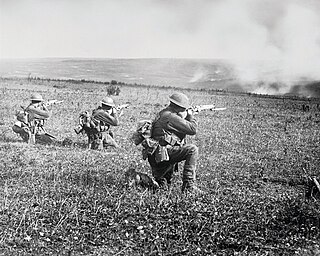
The 12th Brigade was an infantry brigade of the Australian Army. Formed in 1912 as a Militia formation, it was later re-raised in 1916 as part of the all volunteer First Australian Imperial Force that was raised for overseas service during the First World War. The brigade was part of the 4th Division and fought on the Western Front until the end of the war in November 1918. During the inter-war years, the brigade was re-formed in Australia as a part-time unit; during the Second World War, it was mobilised for full-time service, but did not serve overseas, undertaking garrison duties in Australia until 1945 when it was used to raise Timor Force.

The 27th Battalion was an infantry battalion of the Australian Army. It was initially raised in 1915 as part of the all-volunteer First Australian Imperial Force for service during World War I. During the conflict, the battalion saw action briefly at Gallipoli before later fighting on the Western Front between 1916 and 1918. It was disbanded in 1919, but was re-raised in 1921 as part of the Citizens Force, which later became the "Militia". During World War II the battalion was used mainly in a garrison role until the last year of the war when it was committed to the fighting against the Japanese during the Bougainville campaign. Following the end of hostilities it was disbanded in May 1946. Between 1948 and 1965 the battalion was re-raised and disbanded a number of times before eventually becoming part of the Royal South Australia Regiment. It was disbanded for a final time in 1987, when it was amalgamated with the 10th Battalion, Royal South Australia Regiment to form the 10th/27th Battalion, Royal South Australia Regiment.
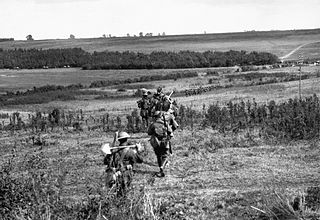
The 5th Pioneer Battalion was an Australian infantry and light engineer unit raised for service during the First World War as part of the all volunteer Australian Imperial Force (AIF). Formed in Egypt in March 1916, the battalion subsequently served on the Western Front in France and Belgium, after being transferred to the European battlefields shortly after its establishment. Assigned to the 5th Division, the 5th Pioneer Battalion fought in most of the major battles that the AIF participated in between mid-1916 and the end of the war in November 1918. It was subsequently disbanded in early 1919.

The 3rd Pioneer Battalion was an Australian infantry and light engineer unit raised for service during the First World War as part of the all volunteer Australian Imperial Force (AIF). Formed in Victoria in March 1916, the battalion subsequently undertook further training in the United Kingdom before arriving in France in late 1916. It later served on the Western Front in France and Belgium until the end of the war. Assigned to the 3rd Division, the 3rd Pioneer Battalion fought in most of the major battles that the AIF participated in between mid-1916 and the end of the war in November 1918. It was subsequently disbanded in early 1919.

The 2nd Pioneer Battalion was an Australian infantry and light engineer unit raised for service during the First World War as part of the all volunteer Australian Imperial Force (AIF). Formed in Egypt in March 1916, the battalion subsequently served on the Western Front in France and Belgium, after being transferred to the European battlefields shortly after its establishment. Assigned to the 2nd Division, the 2nd Pioneer Battalion fought in most of the major battles that the AIF participated in between mid-1916 and the end of the war in November 1918. It was subsequently disbanded in early 1919.

The 1st Pioneer Battalion was an Australian infantry and light engineer unit raised for service during the First World War as part of the all volunteer Australian Imperial Force (AIF). Formed in Egypt in March 1916, the battalion subsequently served on the Western Front in France and Belgium, after being transferred to the European battlefields shortly after its establishment. Assigned to the 1st Division, the 1st Pioneer Battalion fought in most of the major battles that the AIF participated in between mid-1916 and the end of the war in November 1918. It was subsequently disbanded in early 1919.

The 1st Machine Gun Battalion was an infantry support unit of the Australian Army that was raised for service during World War I as part of the all volunteer Australian Imperial Force. It was one of five such units raised as part of the AIF during the war. Formed in March 1918, the battalion consisted of four machine gun companies, which had previously existed as independent companies assigned mainly at brigade level. The battalion consisted of 64 medium machine guns, and took part in the final stages of the war, seeing action during the Allied defensive operations during the German spring offensive and then the Allied Hundred Days Offensive, which finally brought an end to the war. The battalion was disbanded in mid-1919 during the demobilisation of the AIF.
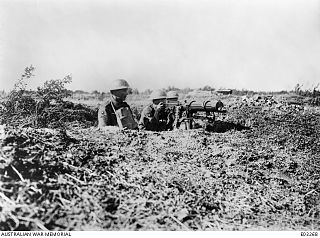
The Australian Machine Gun Corps was a corps of the Australian Army which was formed for service during World War I. It was established in early 1916 as part of a reorganisation of the Australian Imperial Force (AIF) in Egypt as preparations were made to transfer the bulk of the AIF's infantry divisions to Europe to take part in the fighting on the Western Front. Initially, the corps was established into company or squadron sized elements, with a total of 20 companies being raised for service in Europe and four squadrons for service with the Australian Light Horse in the Middle East. In early 1918, the companies deployed to the Western Front were reorganised into five battalions, which were each assigned to an infantry division for defensive and offensive duties. These units were disbanded in mid-1919 following the end of hostilities.

The 2nd Machine Gun Battalion was an infantry support unit of the Australian Army that was raised for service during World War I as part of the all volunteer Australian Imperial Force. It was one of five such units raised as part of the AIF during the war. Formed in March 1918, the battalion consisted of four machine gun companies, which had previously existed as independent companies assigned mainly at brigade level. The battalion consisted of 64 medium machine guns, and took part in the final stages of the war, seeing action during the Allied defensive operations during the German spring offensive and then the Allied Hundred Days Offensive, which finally brought an end to the war. The battalion was disbanded in mid-1919 during the demobilisation of the AIF.
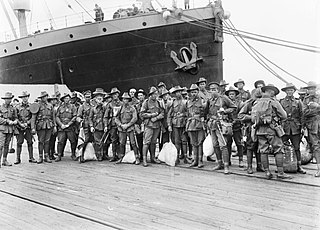
The 5th Machine Gun Battalion was an infantry support unit of the Australian Army. Originally formed in March 1918 for service during World War I as part of the all volunteer Australian Imperial Force, it was one of five such units raised as part of the AIF during the war. The battalion consisted of four machine gun companies, which had previously existed as independent companies assigned mainly at brigade level. The battalion took part in the final stages of the war, seeing action during the Allied defensive operations during the German spring offensive and then the Allied Hundred Days Offensive, which finally brought an end to the war. The battalion was disbanded in mid-1919 during the demobilisation of the AIF following the conclusion of hostilities. During World War II, the battalion was re-raised as part of the Militia in September 1942, and undertook garrison duties in the Torres Strait, until it was disbanded in May 1944.

The 4th Machine Gun Battalion was an infantry support unit of the Australian Army. Originally formed in March 1918 for service during World War I as part of the all volunteer Australian Imperial Force, it was one of five such units raised as part of the AIF during the war. The battalion consisted of four machine gun companies, which had previously existed as independent companies assigned mainly at brigade level. The battalion took part in the final stages of the war, seeing action during the Allied defensive operations during the German spring offensive and then the Allied Hundred Days Offensive, which finally brought an end to the war. The battalion was disbanded in mid-1919 during the demobilisation of the AIF following the conclusion of hostilities.

The 3rd Machine Gun Battalion was an infantry support unit of the Australian Army. Originally formed in March 1918 for service during World War I as part of the all volunteer Australian Imperial Force, it was one of five such units raised as part of the AIF during the war. The battalion consisted of four machine gun companies, which had previously existed as independent companies assigned mainly at brigade level. The battalion took part in the final stages of the war, seeing action during the Allied defensive operations during the German spring offensive and then the Allied Hundred Days Offensive, which finally brought an end to the war. The battalion was disbanded in mid-1919 during the demobilisation of the AIF following the conclusion of hostilities.
The 1st Anzac Entrenching Battalion was a First Australian Imperial Force (AIF) battalion of World War I. It was formed in June 1916 with the role of preparing soldiers for combat with the AIF's infantry battalions. From September that year until the battalion's disbandment in October 1917 it was used as a tunnelling unit.



















